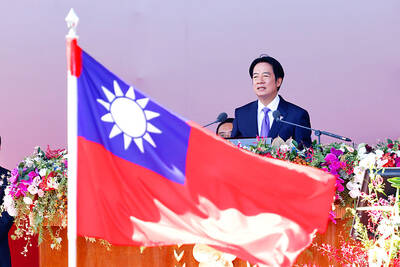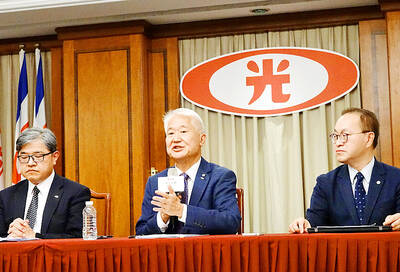US fears that an indigenous satellite launcher capability for Taiwan could help it develop longer-range missiles may have forced Taipei to abandon, or at least delay, the project, sources told the Taipei Times.
After years of relying on foreign space-launch capabilities to lift payloads into space, reports began emerging in 2008 that Taiwan’s National Space Program Office (NSPO) had long-term plans to develop an indigenous satellite and launcher for scientific use.
At the Fourth Asian Space Conference that year, a paper presented by NSPO officials said the agency’s first choice to launch FORMOSAT-6, a micro-satellite under development to carry out scientific investigation, would be the Taiwan Small Launch Vehicle (TSLV).
Another paper presented at the same conference by engineers from various Taiwanese universities said the Taiwan Universities United Satellite NO. 1A, a scientific satellite developed by NSPO in conjunction with a consortium of Taiwanese universities, was expected to be launched by the TSLV, built by the Chung-Shan Institute of Science and Technology (CSIST, 中山科學研究院), into a circular orbit of 500km and at 21 degree inclination.
A cable from the American Institute in Taiwan (AIT) dated April 6, 2009, reported that then-NSPO director-general Miau Jiun-jih (苗君易) had informed the AIT five days earlier that the agency’s long-term plan called for Taiwan to develop an indigenous satellite and launcher and that Taiwan was “very keen for US reaction to that plan.”
The cable said Miau had told the AIT that the TSLV would be locally built in cooperation with CSIST and used to propel locally made satellites weighing between 50kg and 200kg into orbit. A test launch for a 50kg satellite — very likely FORMOSAT-6 — was scheduled for next year to collect data on disaster management and environmental observation.
Based on the lack of progress in developing a TSLV, it appears the US reaction to the plan was negative. US analysts have told the Taipei Times that the involvement of CSIST, the Ministry of National Defense’s principal research and development institution, in the TSLV project, as well as Taiwan’s decision to proceed with the development of the Hsiung Feng-IIE (HF-2E) land-attack cruise missile, may have ensured US opposition to the plan.
According to an October 2009 report by Defense News, in the middle of 2006 the US Department of State began requesting end-user certificates for all export items destined for CSIST and AIT officials were instructed to obtain permission prior to meeting anyone from the research institute. Sources said the intent was to destroy Taiwan’s ability to develop an indigenous missile program, specifically the 600km range HF-2E, and “appease Beijing.”
In January the same year, Taiwan announced it had built three prototypes of the missile and intended to start mass production. US opposition to Taiwan’s missile program was such that a defense expert has linked the development of the HF-2E to Washington’s initial decision to turn down a request by Taipei for 66 F-16C/D aircraft. It is also alleged that a head of CSIST was denied a visa to the US in retaliation for the development of the missile.
The US government regards the HF-2E as an offensive weapon and therefore against the spirit of the Taiwan Relations Act, which stipulates US assistance to Taiwan for weapons and services of a “defensive character.”
Taiwan argues it needs a counterforce arsenal to deter China and to retaliate against missile launch sites in case of attack.
Late last year, the Ministry of National Defense announced it was about to embark on mass production of the HF-2E.
Under Missile Technology Control Regime regulations, and to prevent an arms buildup in the Taiwan Strait, the US Department of State has continually blocked the transfer of missile components to Taiwan to prevent it from building smaller warheads and achieving longer range.
The possible military derivatives associated with the TSLV, especially in achieving delivery of heavier payloads over a longer range for its indigenous missiles, are believed to have played a major role in the US’ decision not to support the NSPO’s launcher plan.
A US official speaking on condition of anonymity said that the US Department of Defense had stayed away from Taiwan’s development of space launch capability, adding that this article’s assessment of US apprehensions over the launcher program, CSIST’s role in it and possible military uses was “correct.”
Asked for comment, AIT spokesperson Christopher Kavanagh said AIT employees and US officials had regular contacts with a broad range of organizations in Taiwan, including CSIST.
However, citing policy on WikiLeaks, Kavanagh would not comment on material included in the AIT cable relating to the NSPO plans for satellite launcher capability. He also declined to confirm whether a visa application by the head of CSIST had been denied.
Taiwan's interest in developing the TSLV appears to have since evaporated.
Contacted for this article, NSPO Deputy Director-General Yu Shiann-jeng (余憲政) said the development strategy at his organization was to concentrate resources on the FORMOSAT-5 and FORMOSAT-7 programs.
“The so-called TSLV is not on the development agenda,” he said in an e-mailed response on Friday, comments that would contradict remarks quoted in the AIT cable by Miau in 2009.
The FORMOSAT-5 is scheduled to be launched by Space Exploration Technologies Corp, a US space transport firm, in 2014 on board a Falcon-1e launch vehicle, while FORMOSAT-7, a joint venture between Taiwan and the US and which would replace the ageing FORMOSAT-3, is under review at the National Science Council.
The launch date for FORMOSAT-6 appears to have been pushed to 2013 or 2014, reportedly as a result of bureaucratic delays and funding inadequacies.

People can preregister to receive their NT$10,000 (US$325) cash distributed from the central government on Nov. 5 after President William Lai (賴清德) yesterday signed the Special Budget for Strengthening Economic, Social and National Security Resilience, the Executive Yuan told a news conference last night. The special budget, passed by the Legislative Yuan on Friday last week with a cash handout budget of NT$236 billion, was officially submitted to the Executive Yuan and the Presidential Office yesterday afternoon. People can register through the official Web site at https://10000.gov.tw to have the funds deposited into their bank accounts, withdraw the funds at automated teller

PEACE AND STABILITY: Maintaining the cross-strait ‘status quo’ has long been the government’s position, the Ministry of Foreign Affairs said Taiwan is committed to maintaining the cross-strait “status quo” and seeks no escalation of tensions, the Ministry of Foreign Affairs (MOFA) said yesterday, rebutting a Time magazine opinion piece that described President William Lai (賴清德) as a “reckless leader.” The article, titled “The US Must Beware of Taiwan’s Reckless Leader,” was written by Lyle Goldstein, director of the Asia Program at the Washington-based Defense Priorities think tank. Goldstein wrote that Taiwan is “the world’s most dangerous flashpoint” amid ongoing conflicts in the Middle East and Russia’s invasion of Ukraine. He said that the situation in the Taiwan Strait has become less stable

CONCESSION: A Shin Kong official said that the firm was ‘willing to contribute’ to the nation, as the move would enable Nvidia Crop to build its headquarters in Taiwan Shin Kong Life Insurance Co (新光人壽) yesterday said it would relinquish land-use rights, or known as surface rights, for two plots in Taipei’s Beitou District (北投), paving the way for Nvidia Corp to expand its office footprint in Taiwan. The insurer said it made the decision “in the interest of the nation’s greater good” and would not seek compensation from taxpayers for potential future losses, calling the move a gesture to resolve a months-long impasse among the insurer, the Taipei City Government and the US chip giant. “The decision was made on the condition that the Taipei City Government reimburses the related

FRESH LOOK: A committee would gather expert and public input on the themes and visual motifs that would appear on the notes, the central bank governor said The central bank has launched a comprehensive redesign of New Taiwan dollar banknotes to enhance anti-counterfeiting measures, improve accessibility and align the bills with global sustainability standards, Governor Yang Chin-long (楊金龍) told a meeting of the legislature’s Finance Committee yesterday. The overhaul would affect all five denominations — NT$100, NT$200, NT$500, NT$1,000 and NT$2,000 notes — but not coins, Yang said. It would be the first major update to the banknotes in 24 years, as the current series, introduced in 2001, has remained in circulation amid rapid advances in printing technology and security standards. “Updating the notes is essential to safeguard the integrity